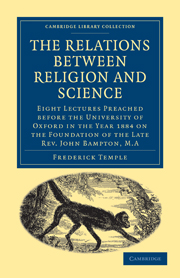 The Relations between Religion and Science
The Relations between Religion and Science Book contents
- Frontmatter
- Contents
- LECTURE I THE ORIGIN AND NATURE OF SCIENTIFIC BELIEF
- LECTURE II THE ORIGIN AND NATURE OF RELIGIOUS BELIEF
- LECTURE III APPARENT CONFLICT BETWEEN SCIENCE AND RELIGION ON FREE-WILL
- LECTURE IV APPARENT CONFLICT BETWEEN RELIGION AND THE DOCTRINE OF EVOLUTION
- LECTURE V REVELATION THE MEANS OF DEVELOPING AND COMPLETING SPIRITUAL KNOWLEDGE
- LECTURE VI APPARENT COLLISION BETWEEN RELIGION AND THE DOCTRINE OF EVOLUTION
- LECTURE VII APPARENT COLLISION OF SCIENCE WITH THE CLAIM TO SUPERNATURAL POWER
- LECTURE VIII THE CONCLUSION OF THE ARGUMENT
LECTURE II - THE ORIGIN AND NATURE OF RELIGIOUS BELIEF
Published online by Cambridge University Press: 29 August 2010
- Frontmatter
- Contents
- LECTURE I THE ORIGIN AND NATURE OF SCIENTIFIC BELIEF
- LECTURE II THE ORIGIN AND NATURE OF RELIGIOUS BELIEF
- LECTURE III APPARENT CONFLICT BETWEEN SCIENCE AND RELIGION ON FREE-WILL
- LECTURE IV APPARENT CONFLICT BETWEEN RELIGION AND THE DOCTRINE OF EVOLUTION
- LECTURE V REVELATION THE MEANS OF DEVELOPING AND COMPLETING SPIRITUAL KNOWLEDGE
- LECTURE VI APPARENT COLLISION BETWEEN RELIGION AND THE DOCTRINE OF EVOLUTION
- LECTURE VII APPARENT COLLISION OF SCIENCE WITH THE CLAIM TO SUPERNATURAL POWER
- LECTURE VIII THE CONCLUSION OF THE ARGUMENT
Summary
‘So God created man in His own image, in the image of God created He him’
Genesis i. 27.THE order of phenomena is not the highest revelation of God, nor is the voice of Science the only nor the most commanding voice that speaks to us about Him. The belief in Him and in the character which we assign to Him does not spring from any observation of phenomena, but from the declaration made to us through the spiritual faculty.
There is within us a voice which tells of a supreme Law unchanged throughout all space and all time; which speaks with an authority entirely its own; which finds corroboration in the revelations of Science, but which never relies on those revelations as its primary or its ultimate sanction; which is no inference from observations by the senses external or internal, but a direct communication from the spiritual kingdom, the kingdom, as philosophers call it, of things in themselves; which commands belief as a duty, and by necessary consequence ever leaves it possible to disbelieve; and in listening to which we are rightly said to walk not by sight but by faith.
Now, before going on to say anything more about the message thus given to us from the spiritual world, it is necessary to consider an objection that meets us on the threshold of all such doctrines, namely, that it is simply impossible for us to know anything whatever of things in themselves.
- Type
- Chapter
- Information
- The Relations between Religion and ScienceEight Lectures Preached before the University of Oxford in the Year 1884 on the Foundation of the Late Rev. John Bampton, M.A., pp. 35 - 66Publisher: Cambridge University PressPrint publication year: 2009First published in: 1884


